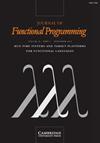Folding left and right matters: Direct style, accumulators, and continuations
IF 1.1
3区 计算机科学
Q4 COMPUTER SCIENCE, SOFTWARE ENGINEERING
引用次数: 1
Abstract
Abstract The equivalence of folding left and right over Peano numbers and lists makes it possible to minimalistically inter-derive (1) structurally recursive functions in direct style, (2) structurally tail-recursive functions that use an accumulator, and (3) structurally tail-recursive functions in delimited continuation-passing style, using Ohori and Sasano’s lightweight fusion by fixed-point promotion. When the fold-left and the fold-right functions account for primitive iteration for Peano numbers, this equivalence is unconditional. When they account for primitive recursion for Peano numbers, this equivalence is modulo left permutativity of their induction-step parameter – a property which is more general than associativity and commutativity. And when they account for primitive iteration or for primitive recursion over lists, this equivalence is modulo left permutativity of their induction-step parameter if these two fold functions have the same type. Since the 1980s, however, the two fold functions for lists do not have the same type: the arguments for their induction-step parameter are swapped, a re-ordering that complicated Bird and Wadler’s duality theorems and whose history is reviewed in an appendix. Without this re-ordering, Bird and Wadler’s second duality theorem more visibly accounts for “re-bracketing,” which is a key step to make recursive programs tail recursive in the general area of program development, from Cooper in the 1960s and onwards.左右折叠事项:直接样式、累加器和延续
摘要在Peano数和列表上左右折叠的等价性使得可以最小地相互推导出(1)直接风格的结构递归函数,(2)使用累加器的结构尾部递归函数,以及(3)定界连续传递风格的结构尾部递推函数,使用Ohori和Sasano的轻量级融合进行定点推广。当左折叠和右折叠函数对皮诺数进行基元迭代时,这种等价性是无条件的。当他们考虑到皮诺数的基元递归时,这种等价性是其归纳步长参数的模左置换性——这一性质比结合性和交换性更一般。当它们考虑到列表上的基元迭代或基元递归时,如果这两个折叠函数具有相同的类型,则这种等价性是它们的归纳步骤参数的模左置换性。然而,自20世纪80年代以来,列表的二重函数没有相同的类型:它们的归纳步长参数的自变量被交换,这一重新排序使Bird和Wadler的对偶定理变得复杂,其历史在附录中回顾。如果没有这种重新排序,Bird和Wadler的第二对偶定理更明显地解释了“重新包围”,这是使递归程序在程序开发的一般领域中尾部递归的关键步骤,从20世纪60年代的Cooper开始。
本文章由计算机程序翻译,如有差异,请以英文原文为准。
求助全文
约1分钟内获得全文
求助全文
来源期刊

Journal of Functional Programming
工程技术-计算机:软件工程
CiteScore
1.70
自引率
0.00%
发文量
9
审稿时长
>12 weeks
期刊介绍:
Journal of Functional Programming is the only journal devoted solely to the design, implementation, and application of functional programming languages, spanning the range from mathematical theory to industrial practice. Topics covered include functional languages and extensions, implementation techniques, reasoning and proof, program transformation and synthesis, type systems, type theory, language-based security, memory management, parallelism and applications. The journal is of interest to computer scientists, software engineers, programming language researchers and mathematicians interested in the logical foundations of programming.
 求助内容:
求助内容: 应助结果提醒方式:
应助结果提醒方式:


